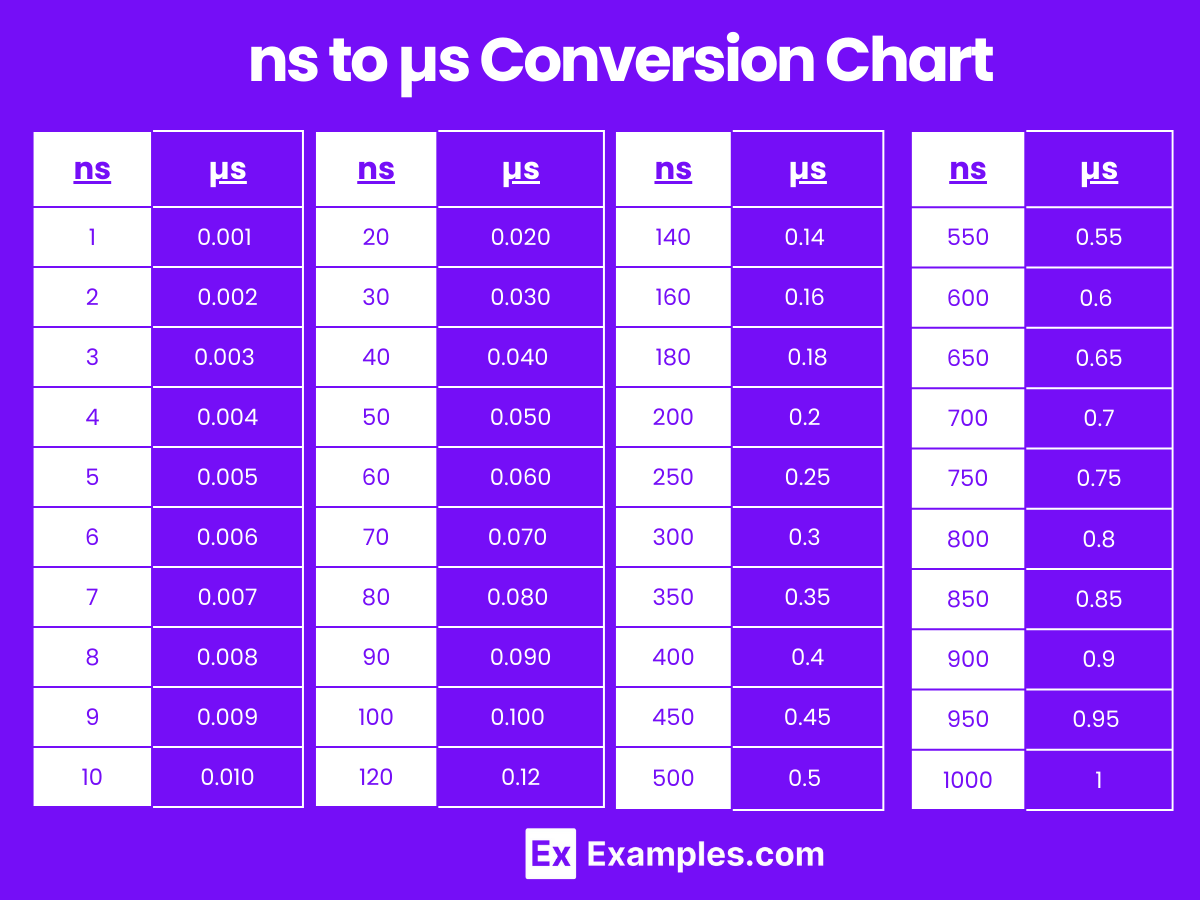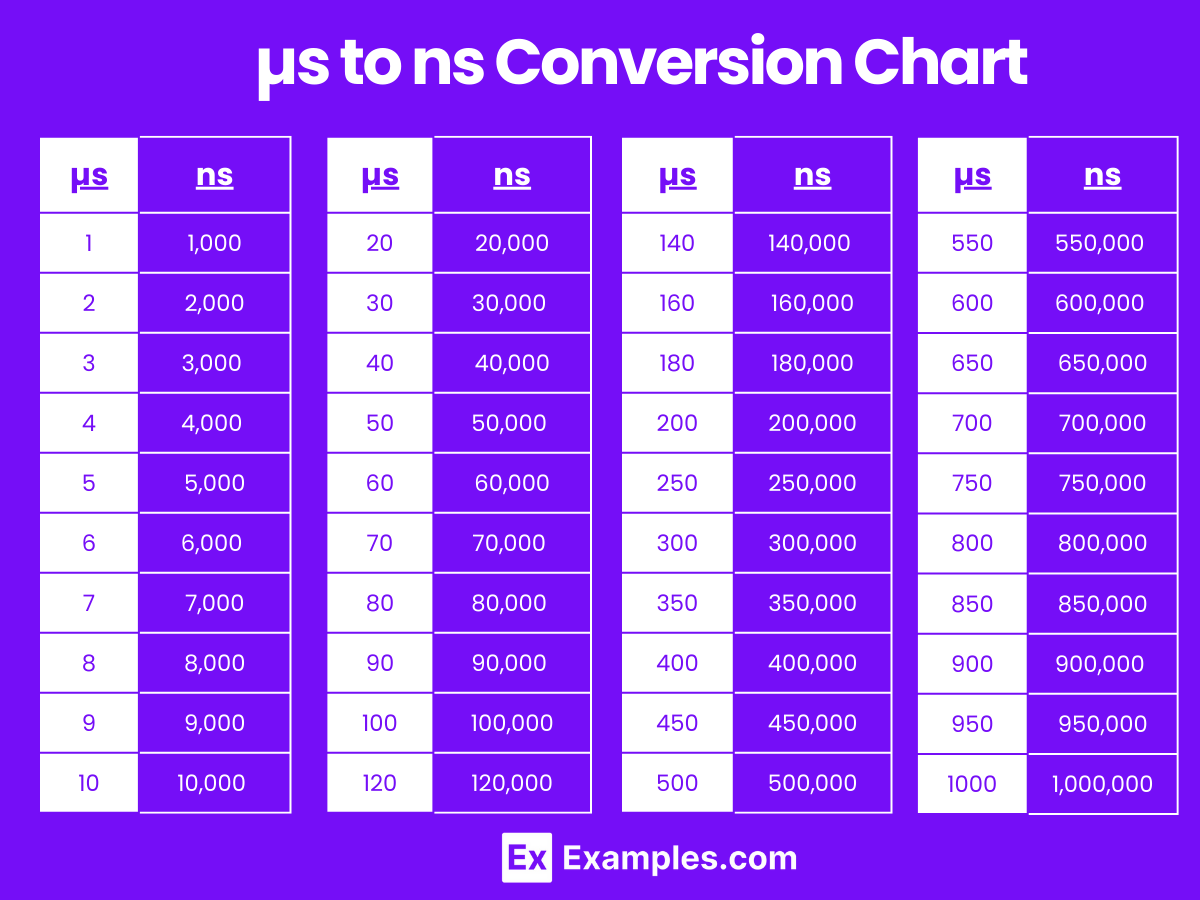Easily convert nanoseconds to microseconds and vice versa with Examples.com. Input your values and get instant conversion results.
ns to microSeconds
Formula: Length in microseconds = Length in nanoseconds × 0.001
Nanoseconds:
Microseconds:
| Nanoseconds | Microseconds | Exponential |
|---|---|---|
| 1 | 0.001 | 1e-3 |
microSeconds to ns
Formula: Length in nanoseconds = Length in microseconds × 1000
Microseconds:
Nanoseconds:
| Microseconds | Nanoseconds | Exponential |
|---|---|---|
| 1 | 1000 | 1e+3 |
Time Converters to Nanosecond (nm)
Time Converters to Microsecond (µm)
Conversion Factors:
- Nanoseconds to Microseconds: 1 microsecond = 1,000 nanoseconds
- Microseconds to Nanoseconds: 1 nanosecond = 1/1,000 microseconds
How to Convert Nanoseconds to Microseconds
To convert nanoseconds to microseconds, multiply the number of nanoseconds by 0.0010.0010.001 (since 1 nanosecond is equal to 0.001 microseconds).
Microseconds=Nanoseconds×0.001
Example:
Convert 2,000 nanoseconds to microseconds:
Microseconds=2,000×0.001=2 microseconds
How to Convert Microseconds to Nanoseconds:
To convert microseconds to nanoseconds, multiply the number of microseconds by 1,000.
Nanoseconds=Microseconds×1,000
Example:
Convert 3 microseconds to nanoseconds.
Nanoseconds=3×1,000=3,000 nanoseconds
Nanosecond to Microsecond Conversion Table
| Nanoseconds (ns) | Microseconds (µs) |
|---|---|
| 1 ns | 0.001 µs |
| 2 ns | 0.002 µs |
| 3 ns | 0.003 µs |
| 4 ns | 0.004 µs |
| 5 ns | 0.005 µs |
| 6 ns | 0.006 µs |
| 7 ns | 0.007 µs |
| 8 ns | 0.008 µs |
| 9 ns | 0.009 µs |
| 10 ns | 0.010 µs |
| 20 ns | 0.020 µs |
| 30 ns | 0.030 µs |
| 40 ns | 0.040 µs |
| 50 ns | 0.050 µs |
| 60 ns | 0.060 µs |
| 70 ns | 0.070 µs |
| 80 ns | 0.080 µs |
| 90 ns | 0.090 µs |
| 100 ns | 0.100 µs |
ns to µs Conversion Chart

Microsecond to Nanosecond Conversion Table
| Microseconds (µs) | Nanoseconds (ns) |
|---|---|
| 1 µs | 1,000 ns |
| 2 µs | 2,000 ns |
| 3 µs | 3,000 ns |
| 4 µs | 4,000 ns |
| 5 µs | 5,000 ns |
| 6 µs | 6,000 ns |
| 7 µs | 7,000 ns |
| 8 µs | 8,000 ns |
| 9 µs | 9,000 ns |
| 10 µs | 10,000 ns |
| 20 µs | 20,000 ns |
| 30 µs | 30,000 ns |
| 40 µs | 40,000 ns |
| 50 µs | 50,000 ns |
| 60 µs | 60,000 ns |
| 70 µs | 70,000 ns |
| 80 µs | 80,000 ns |
| 90 µs | 90,000 ns |
| 100 µs | 100,000 ns |
µs to ns Conversion Chart

Difference Between Nanosecond to Microsecond
| Aspect | Nanosecond (ns) | Microsecond (µs) |
|---|---|---|
| Definition | One billionth of a second | One millionth of a second |
| Conversion Factor | 1 ns = 0.001 µs | 1 µs = 1,000 ns |
| Usage | Used for extremely precise time measurements | Used for precise but slightly larger time measurements |
| Applications | High-speed electronics, optical communication | Audio processing, radar technology |
| Measurement Range | Suitable for very short time intervals | Suitable for short time intervals |
| Scale | Smaller than microsecond | Larger than nanosecond |
| Scientific Notation | 1 ns = 10^-9 seconds | 1 µs = 10^-6 seconds |
| Example | Light travels approximately 0.3 mm in 1 ns | Light travels approximately 300 meters in 1 µs |
| Technology Use | Used in high-frequency trading systems | Used in data acquisition systems |
| Importance | Critical for time-sensitive applications | Important for systems requiring quick response |
1. Solved Examples on Converting Nanosecond to Microsecond
Example 1
Problem: Convert 5,000 nanoseconds to microseconds
Solution: Microseconds = 5,000 × 0.001 = 5 µs
Example 2
Problem: Convert 12,000 nanoseconds to microseconds
Solution: Microseconds = 12,000 × 0.001 = 12 µs
Example 3
Problem: Convert 25,000 nanoseconds to microseconds
Solution: Microseconds = 25,000 × 0.001 = 25 µs
Example 4
Problem: Convert 50,000 nanoseconds to microseconds
Solution: Microseconds = 50,000 × 0.001 = 50 µs
Example 5
Problem: Convert 100,000 nanoseconds to microseconds
Solution: Microseconds = 100,000 × 0.001 = 100 µs
2. Solved Examples on Converting Microsecond to Nanosecond
Example 1
Problem: Convert 2 microseconds to nanoseconds
Solution: Nanoseconds = 2 × 1,000 = 2,000 ns
Example 2
Problem: Convert 5 microseconds to nanoseconds
Solution: Nanoseconds = 5 × 1,000 = 5,000 ns
Example 3
Problem: Convert 8 microseconds to nanoseconds
Solution: Nanoseconds = 8 × 1,000 = 8,000 ns
Example 4
Problem: Convert 12 microseconds to nanoseconds
Solution: Nanoseconds = 12 × 1,000 = 12,000 ns
Example 5
Problem: Convert 20 microseconds to nanoseconds
Solution: Nanoseconds = 20 × 1,000 = 20,000 ns
How are nanoseconds and microseconds used in computing?
In computing, nanoseconds are often used to measure CPU clock speeds and memory access times, while microseconds are used to measure data transfer rates and network latency.
Why is it important to understand the difference between nanoseconds and microseconds?
Understanding the difference between nanoseconds and microseconds is crucial in fields like computing, telecommunications, and electronics, where precise time measurements can impact the performance and reliability of systems and devices.
What are some practical applications of nanoseconds and microseconds?
Nanoseconds are used in applications such as high-frequency trading, computer processing speeds, and synchronization of electronic circuits. Microseconds are used in applications like data transmission rates, response times in communication networks, and timing of electrical signals.
Are there any tools or calculators available for converting nanoseconds to microseconds?
Yes, many online conversion tools and calculators can help you quickly convert nanoseconds to microseconds. Simply enter the value in nanoseconds, and the tool will provide the equivalent value in microseconds.
How do scientists measure time intervals in nanoseconds and microseconds?
Scientists use high-precision instruments such as oscilloscopes, time interval analyzers, and atomic clocks to measure time intervals in nanoseconds and microseconds accurately.

